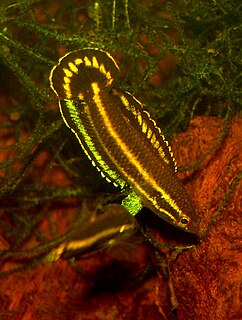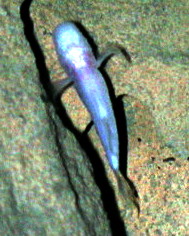
Synbranchiformes, often called swamp eels, is an order of ray-finned fishes that are eel-like but have spiny rays, indicating that they belong to the superorder Acanthopterygii.

The swamp eels are a family (Synbranchidae) of freshwater eel-like fishes of the tropics and subtropics. Most species are able to breathe air and typically live in marshes, ponds and damp places, sometimes burying themselves in the mud if the water source dries up. They have various adaptations to suit this lifestyle; they are long and slender, they lack pectoral and pelvic fins, and their dorsal and anal fins are vestigial, making them limbless vertebrates. They lack scales and a swimbladder, and their gills open on the throat in a slit or pore. Oxygen can be absorbed through the lining of the mouth and pharynx, which is rich in blood vessels and acts as a "lung".
The spring cavefish is the only member of the genus Forbesichthys and is one of seven species in the family Amblyopsidae. This species is listed as state endangered in Missouri, but it is considered to be of least concern by the IUCN Red List due to its relatively large population size and number of subpopulations. The spring cavefish inhabits caves, springs, spring runs, and spring seeps. It is subterranean, emerging at dusk and retreating underground an hour or two before dawn. The species is located within areas of the central and southeastern United States. It stays underground after dawn, but then emerges into surface waters at dusk. They are a carnivorous fish and are well adapted to their environment. The species' breeding behavior is rarely documented. Spawning occurs underground and in darkness between January and April. The status and distribution of cave-obligate species is incomplete or lacking entirely, which makes conservation and management decisions difficult. Kentucky and Missouri are the two main states that have their agencies managing this species in some way.

The Mary River turtle is an endangered short-necked turtle that is endemic to the Mary River in south-east Queensland, Australia. While, the Mary River Turtle was first formerly discovered in 1994, they eluded discovery in their natural environment for nearly 30 years. There has been a dramatic decrease in their population due to low reproduction rates and an increase of depredation on nests.
A blind fish is a fish without functional eyes. Most blind fish species are found in dark habitats such as the deep ocean, deep river channels and underground.
The Georgia blind salamander is a species of salamander in the family Plethodontidae. It is endemic to the south-eastern United States where its natural habitats are inland karsts, caves and subterranean habitats. It is listed as "Vulnerable" by the IUCN and is threatened by habitat loss.
The Bombay swamp eel, also known as the paytop in Marathi, is a species of fish in the family Synbranchidae. It is endemic to the state of Maharashtra in India.

The Mexican blind brotula is a species of viviparous brotula endemic to Mexico, where it is found in sinkholes and caves. It is known as sak kay in Mayan and dama blanca ciega in Spanish. This cavefish grows to a standard length of 9.7 cm (3.8 in). It is the only known member of its genus.

The blind cave eel is a species of fish in the family Synbranchidae. It is endemic to subterranean waters in the coastal Pilbara region and Barrow Island. Like other cavefish such as Milyeringa, the blind cave eel is entirely blind and lacks pigmentation. It is listed as vulnerable under the Australian Environment Protection and Biodiversity Conservation Act 1999. Reaching a length of 40 cm (16 in), it is the longest known cavefish.

Ophisternon is a genus of swamp eels found in fresh and brackish waters in South and Southeast Asia, New Guinea, Australia, Middle America and West Africa. Two species are blind cave-dwellers.

Parosphromenus harveyi is a species of gourami endemic to Malaysia, where it is only known from Selangor. The most extreme freshwater habitats in Peninsular Malaysia is the peat swamp forest that consist of dark-coloured and highly acidic waters. Parosphromenus harveyi is known as licorice gourami, small labyrinth fishes located within the north Selangor peat swamp forest from the Tanjong Malim area in neighbouring Perak state at least one population distribution that exhibit a wide variety of morphological and behavioural traits. Species of the osphronemid genus Parosphromenus that stenotypic inhabitant of peat swamp forests and associated black water streams which has a very little light penetrates. Parosphromenus was established by Brown, 1987. Since 1950s, the additional taxa have been described on a sporadic basis and there are 20 recognised members at present.
The juil ciego or blindwhiskered catfish is a species of three-barbeled catfish endemic to Mexico. This species is troglobitic, inhabiting a certain stream that flows through a single cave system.
Stygichthys typhlops, the blind tetra or Brazilian blind characid, is a species of fish in the family Characidae and the only member of the genus Stygichthys. It is endemic to caves in northern Minas Gerais, Brazil. Like other cave-adapted fish, the Brazilian blind characid is blind and lacks pigmentation. It reaches up to about 4.6 cm (1.8 in) in standard length. It is solitary and when kept together in an aquarium, individuals are indifferent to each other.

Typhlichthys subterraneus, the southern cavefish, is a species of cavefish in the family Amblyopsidae endemic to karst regions of the eastern United States.

Cavefish or cave fish is a generic term for fresh and brackish water fish adapted to life in caves and other underground habitats. Related terms are subterranean fish, troglomorphic fish, troglobitic fish, stygobitic fish, phreatic fish and hypogean fish.

Synbranchus is a genus of swamp eels native to Central and South America.
Ophichthys desilvai is a commercially important, air-breathing species of fish in the family Synbranchidae. It is endemic to Sri Lanka and is the only endemic synbranchid from there.

Ophisternon bengalense the Bengal eel, Bengal mudeel or onegill eel, is a species of fish in the family Synbranchidae. It is endemic to freshwater and brackish water rivers and swamps in Oceania and South Asia. It is normally 100 cm in maximum length.
Rakthamichthys is a genus of swamp eels that are endemic to India. Three species are known from the Western Ghats and one is known from Northeast India.











